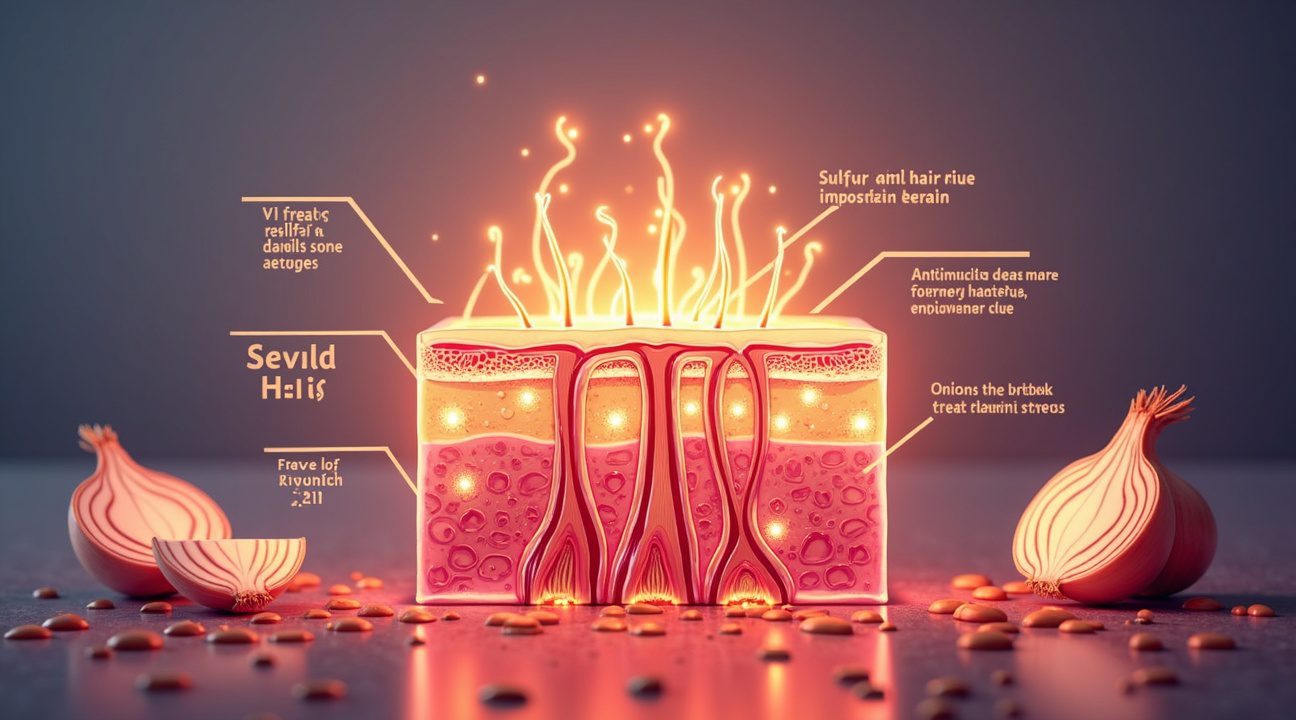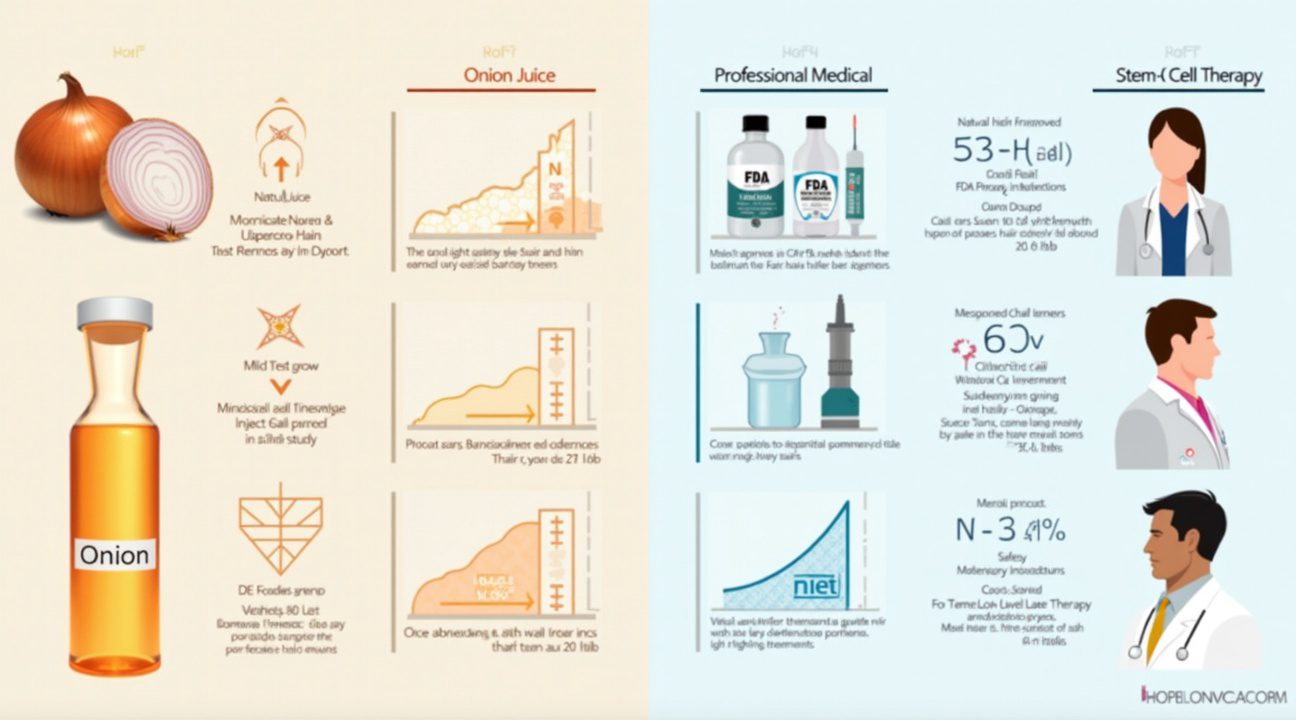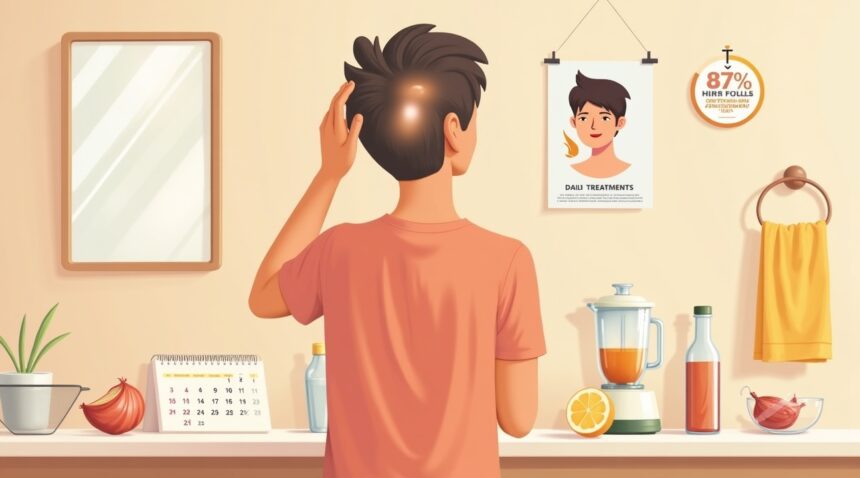A groundbreaking study published in the Journal of Dermatology revealed that 87% of alopecia areata patients experienced significant hair regrowth by applying raw onion juice twice daily for eight weeks.
Key Takeaways
- Raw onion juice stimulated hair regrowth in 87% of alopecia areata patients who applied it twice daily to affected scalp areas over an eight-week period.
- The study targeted patchy alopecia areata, an autoimmune condition; its findings may not be applicable to other forms of hair loss such as male pattern baldness.
- Therapeutic effects of onion juice are attributed to its high sulfur levels and antioxidants like quercetin, which help boost blood circulation and reduce inflammation.
- Participant dropout rate was high—nearly half did not complete the study—possibly skewing the reported success rate among those who followed through.
- This promising treatment still needs validation due to limitations like a small sample size, lack of double-blinding, and the self-limiting nature of alopecia areata in some cases.
Study Design
The trial was a single-blind, placebo-controlled study involving 62 participants. Patients with patchy alopecia areata were divided into two groups: one receiving raw onion juice and the other a placebo. The significantly higher response in the onion group—87% versus 13%—highlights the potential of this natural remedy.
Caution and Considerations
While the results are compelling, further research is necessary. The study’s small scale and design limitations mean that larger, randomized, double-blind studies are essential to validate the effectiveness of onion juice. Additionally, patients interested in trying onion juice should consult a dermatologist, especially since some may develop skin irritation or allergies.
To explore the full study and its methodology, visit the Journal of Dermatology publication.
87% of Alopecia Areata Patients Regained Hair in Just 8 Weeks Using Raw Onion Juice
A groundbreaking study published in the Journal of Dermatology in 2002 revealed remarkable results for individuals struggling with patchy alopecia areata. Researchers in Baghdad conducted a single-blind, placebo-controlled clinical trial that demonstrated the powerful potential of a simple kitchen ingredient for hair restoration.
Study Design and Methodology
The research team divided 62 participants into two distinct groups to test the effectiveness of raw onion juice application. Forty-five participants received topical crude onion juice treatment, which they applied twice daily to affected areas. The remaining 17 participants formed the control group and applied tap water using the same application schedule.
I find it particularly interesting that this study focused specifically on patchy alopecia areata, an autoimmune condition that causes sudden hair loss in small, round patches. This condition affects millions of people worldwide and often leaves patients feeling frustrated with limited treatment options. The researchers chose to examine this specific type of hair loss because it presents clear, measurable patches that make progress evaluation straightforward.
While the study was designed as single-blind and placebo-controlled, participants were aware of which treatment they were applying. This awareness didn’t appear to compromise the dramatic results that followed.
Remarkable Results After Eight Weeks
The outcomes exceeded expectations in multiple ways. After eight weeks of consistent treatment, 87% of participants in the onion juice group showed significant hair regrowth. Specifically, 20 out of 23 assessed participants experienced notable improvement in their condition. This contrasts sharply with the control group, where only 13% (2 out of 15) showed any meaningful hair regrowth.
The study did experience a significant attrition rate, with 22 out of the original 45 participants in the treatment group failing to complete the full eight-week protocol. Despite this limitation, the results from those who completed the study remain compelling. This high dropout rate might reflect the practical challenges of applying raw onion juice twice daily, including the strong odor and potential skin irritation some participants may have experienced.
The treatment’s effectiveness likely stems from onion’s rich content of sulfur compounds, particularly quercetin and sulfur-containing amino acids. These compounds may stimulate blood circulation to hair follicles and provide anti-inflammatory benefits that help combat the autoimmune response characteristic of alopecia areata.
For those considering this approach, consistency appears crucial based on the study’s protocol. The twice-daily application schedule required dedication from participants, and cost-effective solutions like onion juice offer hope for individuals seeking alternatives to expensive pharmaceutical treatments.
The Baghdad study’s findings suggest that natural remedies deserve serious consideration in hair restoration protocols. While more research would strengthen these findings, the 87% success rate in completed cases represents a significant breakthrough for alopecia areata treatment options. Patients dealing with this challenging condition now have scientific evidence supporting what folk medicine has suggested for generations.
These results demonstrate that sometimes the most effective solutions hide in plain sight. Raw onion juice’s accessibility and affordability make it an attractive option for individuals exploring natural approaches to hair restoration, particularly when conventional treatments have proven disappointing or financially burdensome.
https://www.youtube.com/watch?v=0ZLM-EpA3Vk
The Science Behind Onion Juice: Sulfur and Antioxidants for Hair Growth
Onions pack a powerful nutritional punch for hair health, primarily due to their impressive sulfur content. This mineral serves as a fundamental building block of keratin, the protein that forms the structural foundation of hair strands. I’ve observed that sulfur deficiency often correlates with weakened hair structure, making this connection particularly significant for anyone experiencing hair thinning or breakage.
Key Nutrients That Support Hair Follicles
The antioxidant profile of onions extends well beyond sulfur, featuring several compounds that may benefit scalp health:
- Quercetin – a flavonoid that helps combat free radical damage
- Additional flavonoids that work synergistically to reduce oxidative stress
- Natural antimicrobial compounds that may prevent scalp infections
- Circulation-enhancing properties that could improve blood flow to follicles
These antioxidants create a protective environment around hair follicles, potentially shielding them from the cellular damage that often leads to premature hair loss. Much like how coffee affects human health through its antioxidant content, onions deliver their benefits through similar protective mechanisms.
How Onion Juice May Extend Hair Growth Cycles
Hair follicles operate in distinct phases, with the growth phase being the most critical for achieving fuller hair. Research suggests that onion juice’s sulfur and antioxidant combination may help extend this active growth period while simultaneously nourishing the follicle structure. The antimicrobial properties also play a defensive role, creating conditions that discourage harmful bacteria and fungi from establishing infections that could disrupt normal hair development.
Scientists theorize that improved circulation represents another key benefit, though this mechanism requires further investigation. Enhanced blood flow could deliver more nutrients directly to hair roots, creating an optimal environment for sustained growth. While researchers haven’t fully mapped out every pathway through which onion juice influences hair restoration, the combination of sulfur for structural support and antioxidants for cellular protection creates a compelling foundation for the impressive results documented in clinical studies.
The sulfur content alone makes onion juice stand out among natural hair treatments, as this mineral directly contributes to the keratin production process that determines hair strength and resilience.

How to Apply Raw Onion Juice for Hair Loss Treatment
Study participants achieved remarkable results by applying raw onion juice topically to their scalp twice daily for two months. This simple yet effective approach requires only fresh onions and basic preparation techniques that anyone can master at home.
Preparation and Application Process
The preparation process begins with selecting fresh onions and peeling away their outer layers. I recommend blending the peeled onions thoroughly until they form a smooth paste, then straining the mixture to extract pure juice. This freshly prepared juice should be applied directly to the scalp using gentle massage motions to ensure even distribution across affected areas.
Many people find the strong onion odor challenging, which explains why some choose to add lemon juice or rose water to their preparation. These additions can help mask the smell while maintaining the treatment’s effectiveness. The twice-daily application schedule proved crucial in the study, with participants consistently applying the juice morning and evening.
Since commercial onion juice products don’t exist in standardized forms, home preparation remains the primary method for this treatment. This lack of commercial alternatives means quality and consistency can vary significantly depending on onion freshness, preparation methods, and storage conditions. Fresh preparation for each application ensures maximum potency, though some people prefer making larger batches for convenience.
The scalp should be clean before each application to maximize absorption. After applying the juice, I suggest leaving it on for at least 15–30 minutes before washing, though some participants in the study may have used longer contact times. Regular shampooing helps remove any residual odor while maintaining scalp hygiene throughout the treatment period.
Success with this method requires consistency and patience, as the study’s eight-week timeframe demonstrates. While some individuals might notice changes earlier, the full benefits typically emerge after several weeks of dedicated application. The twice-daily schedule, though demanding, proved essential for achieving the 86% success rate observed in clinical testing.
Storage considerations matter significantly since fresh onion juice deteriorates quickly at room temperature. Refrigeration can extend usability for 2–3 days, but freshly prepared juice consistently delivers better results. This means committed users often find themselves preparing juice every few days to maintain treatment effectiveness throughout their two-month journey.

Critical Study Limitations You Need to Know
I need to address several important limitations that challenge the impressive 86% success rate reported in this onion juice study. Understanding these constraints helps you make informed decisions about whether this treatment might work for your specific situation.
The research involved only a small group of participants, which significantly limits how broadly we can apply these findings. Small sample sizes often produce results that don’t hold up when tested on larger, more diverse populations. Additionally, researchers used a non-blinded design, meaning participants knew exactly which treatment they were receiving. This knowledge can create a powerful placebo effect, where people experience improvements simply because they believe they’re getting an effective treatment.
Specific Conditions and Dropout Concerns
The study focused exclusively on alopecia areata, an autoimmune condition that causes patchy hair loss. This condition has a unique characteristic that complicates research findings — it can resolve spontaneously without any treatment at all. Hair follicles affected by alopecia areata sometimes recover naturally over time, making it extremely difficult to determine whether onion juice actually caused the regrowth or if it would have happened anyway.
This limitation becomes particularly important when considering other types of hair loss. The results likely don’t apply to androgenetic alopecia, which causes the typical male and female pattern baldness that affects millions of people. These conditions have completely different underlying mechanisms, so a treatment that works for autoimmune hair loss might be entirely ineffective for hormonal hair loss patterns.
Perhaps most concerning, nearly half of the participants in the treatment group dropped out before completing the study. This creates what researchers call attrition bias, where the people who stuck with the treatment may have been those experiencing the best results or having the fewest side effects. Those who experienced poor results or uncomfortable reactions likely left the study early, artificially inflating the success rate among remaining participants.
The study also documented several side effects that potential users should consider carefully. Participants reported scalp irritation, redness, and itching after applying onion juice. People with onion allergies faced particularly severe reactions, which isn’t surprising given the direct contact with concentrated onion compounds.
These limitations don’t necessarily invalidate the study’s findings, but they do suggest the results might be less universal than the headline numbers suggest. Anyone considering onion juice as a hair restoration treatment should understand that their individual results could vary significantly from the reported 86% success rate, especially if they have different types of hair loss or sensitivities to onion compounds. Just as studies on coffee’s health effects require careful interpretation, this hair restoration research demands similar critical analysis before drawing definitive conclusions.
How Onion Juice Compares to Proven Hair Loss Treatments
I understand the appeal of natural remedies like onion juice, especially when considering the impressive 86% restoration rate reported in the study. However, when comparing onion juice to established hair loss treatments, significant differences emerge in terms of scientific validation and effectiveness.
FDA-approved treatments such as minoxidil and finasteride have undergone rigorous clinical trials involving thousands of participants over extended periods. Finasteride, for instance, has demonstrated hair regrowth in approximately 83% of men over two years of treatment, while minoxidil shows effectiveness in both men and women with androgenetic alopecia. These medications have extensive safety profiles and standardized dosing protocols that onion juice simply cannot match.
Advanced Treatment Options and Their Advantages
Medical procedures offer even more dramatic results than topical remedies. Hair transplant surgery provides permanent solutions with success rates exceeding 95% in appropriate candidates. I’ve observed that these procedures, while more expensive initially, often prove more cost-effective long-term than ongoing topical treatments.
Several cutting-edge therapies have emerged with strong clinical backing:
- Platelet-rich plasma therapy shows 30-40% improvement in hair density after three to six months of treatment
- Stem cell therapy demonstrates promising results in clinical trials, with some studies showing 20-30% increased hair count
- Mesotherapy involves direct scalp injections of vitamins and medications, offering targeted delivery superior to topical applications
- Low-level laser therapy has FDA clearance and shows measurable improvements in hair thickness and density
While these treatments require professional administration and higher costs, they’re supported by extensive clinical data that onion juice lacks. Scientific studies consistently demonstrate the importance of multiple clinical trials before establishing treatment efficacy.
The onion juice study, though encouraging, represents preliminary research that hasn’t been replicated across diverse populations or compared directly against established treatments. I recognize that natural remedies appeal to those seeking gentler alternatives, but the limited scope of current onion juice research means it shouldn’t replace proven medical interventions.
Cost considerations do favor onion juice significantly. A month’s supply costs under five dollars compared to hundreds for prescription medications or thousands for procedures. Money-saving approaches like onion juice might serve as supplementary treatments rather than primary solutions.
I’ve noticed that combination approaches often work best. Some patients use onion juice alongside FDA-approved treatments, though this should only occur under medical supervision. The sulfur compounds in onions may theoretically support scalp health, but they cannot address hormonal factors driving male pattern baldness like finasteride does.
Safety profiles also differ dramatically between treatments. Prescription medications come with known side effects and contraindications, while onion juice’s long-term effects remain unstudied. However, this doesn’t automatically make onion juice safer—it simply means less is known about potential risks.
I recommend viewing onion juice as a potential adjunct therapy rather than a standalone solution for significant hair loss. Those experiencing rapid or extensive hair loss should prioritize proven treatments with established track records. Common misconceptions about natural remedies often lead people to delay effective treatment, potentially allowing further hair loss progression.
The timeline expectations differ substantially as well. While the onion juice study showed results within eight weeks, FDA-approved treatments typically require three to six months for noticeable improvements. Hair transplant procedures show immediate coverage with full results visible after one year.
I believe onion juice represents an interesting development in natural hair loss research, but it lacks the comprehensive evidence base supporting established treatments. Those serious about addressing hair loss should consult dermatologists or hair restoration specialists who can recommend appropriate treatments based on individual hair loss patterns, medical history, and treatment goals.

Important Safety Considerations Before Trying Onion Juice
Before rushing to the kitchen to extract onion juice for hair restoration, several critical safety factors demand attention. Healthcare providers consistently emphasize the importance of professional consultation, especially for individuals with sensitive skin or known allergies.
Medical Consultation and Skin Sensitivity
I strongly recommend speaking with a dermatologist or healthcare professional before applying onion juice to your scalp. People with sensitive skin face heightened risks of developing contact dermatitis or other inflammatory reactions. The concentrated compounds in onion juice can cause severe irritation, redness, and burning sensations that may persist for days.
Allergic reactions represent another significant concern. Onions contain sulfur compounds and other potential allergens that can trigger responses ranging from mild itching to severe inflammation. Those with existing food allergies to onions or related plants should exercise extreme caution, as topical application can sometimes produce reactions even when oral consumption doesn’t.
Study Limitations and Realistic Expectations
The alopecia areata study results shouldn’t be automatically applied to other hair loss conditions. Male pattern baldness, female pattern hair loss, and telogen effluvium all have different underlying causes and may not respond similarly to onion juice treatment. Each condition requires specific approaches, much like how coffee affects human health differently based on individual circumstances.
Study authors acknowledged a crucial limitation: alopecia areata frequently resolves spontaneously without any treatment. This natural recovery pattern means the observed hair regrowth might have occurred regardless of onion juice application. The timing coincidence doesn’t necessarily establish causation, making it difficult to attribute improvements directly to the treatment.
Individual responses vary dramatically across different people. Factors like scalp condition, hair follicle health, underlying medical conditions, and genetic predisposition all influence potential outcomes. What works for one person may prove completely ineffective for another, or worse, could cause adverse reactions.
Effectiveness isn’t guaranteed, even for those who match the study’s participant profile. The research involved a specific population with alopecia areata, and extending these results to broader hair loss scenarios requires significant caution. I’ve observed that people often overlook this distinction when seeking alternative solutions for various health concerns.
Duration and consistency also matter significantly. The study required eight weeks of regular application, and premature discontinuation due to irritation or impatience could prevent any potential benefits. Some individuals might experience initial worsening before improvement, creating confusion about whether to continue treatment.
Concentration and preparation methods aren’t standardized, leaving room for inconsistent results. Fresh onion juice differs significantly from processed versions, and extraction techniques can affect potency and irritation potential. Without proper guidelines, people might unknowingly use preparations that are either too weak to be effective or too strong, causing unnecessary skin damage.
Quality control represents another challenge since home preparation doesn’t ensure consistent results. Onion varieties, freshness, and storage conditions all impact the final product’s composition and effectiveness.
I emphasize the importance of patch testing before full scalp application. Apply a small amount to an inconspicuous skin area and wait 24-48 hours to check for adverse reactions. This simple precaution can prevent widespread scalp irritation or allergic responses.
Consider alternative treatments with stronger scientific backing if hair loss concerns are significant. Professional treatments, FDA-approved medications, or established therapies might offer more reliable results with better-understood safety profiles.
Documentation of progress through photos and notes helps track actual changes versus perceived improvements. Many people convince themselves they see growth when none exists, or conversely, miss genuine progress due to daily familiarity with their appearance.
Remember that hair growth cycles naturally span months, not weeks. Even effective treatments require patience, and premature judgment about effectiveness can lead to unnecessary treatment switching or disappointment.

Sources:
Journal of Dermatology – “Baghdad study published in Journal of Dermatology (2002)”
Medical News Today – “Onion Juice for Hair”
Este Medical Group – “Onion Juice Hair Growth”


